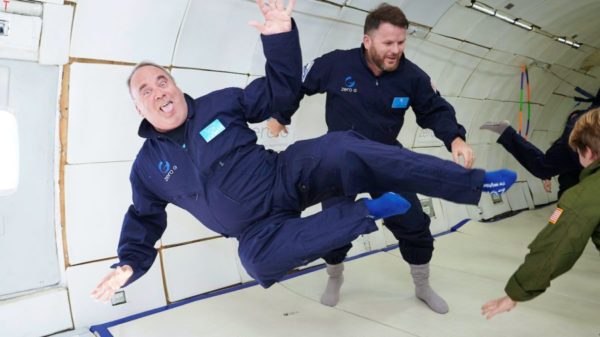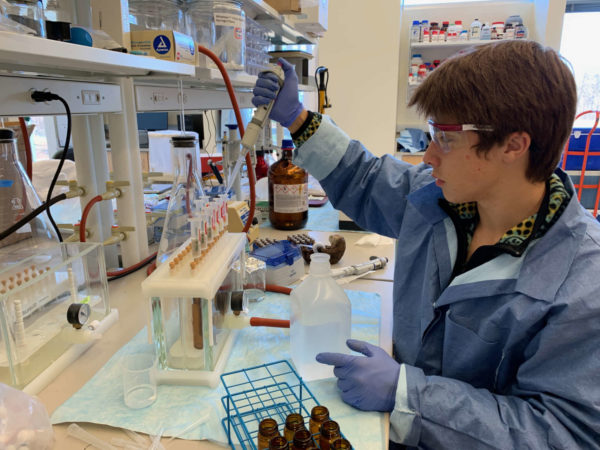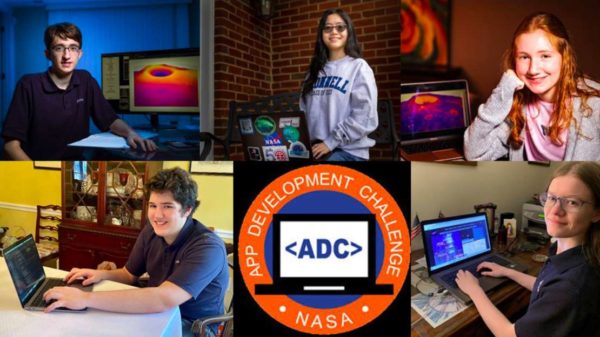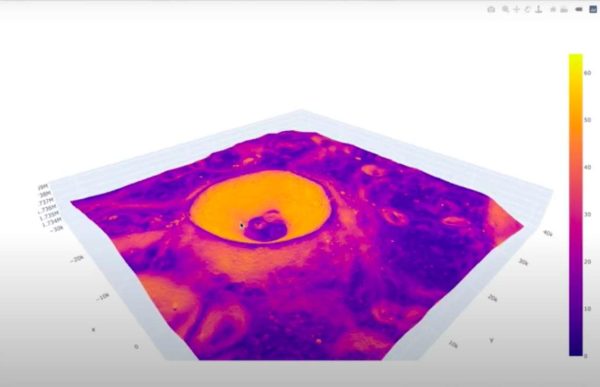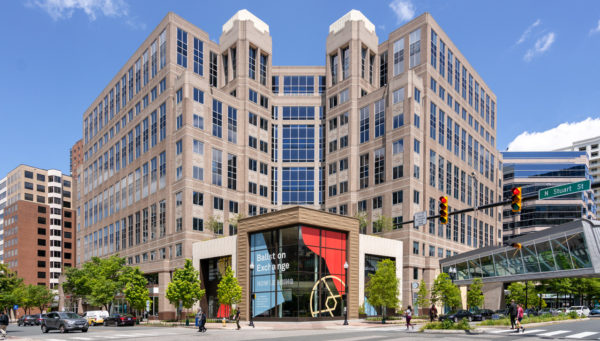One meeting down and two more to go before recommendations could emerge for a new name to adorn the forthcoming Arlington Career Center building.
Arlington Public Schools last month created a naming committee to discuss potential names for the new building, which will house the Arlington Career Center and the handful of programs within it, including Arlington Tech. As the committee has just starting meeting, no contenders have yet emerged for the building on S. Walter Reed Drive, slated for completion in the fall of 2026.
“It’s been a really great learning experience because we found out that there are clear criteria for how you name a new building in Arlington,” such as inclusive discussions with the community and a pick that reflects its values and the education happening inside, says Margaret Chung, the principal of the Arlington Career Center (ACC).
“Whether you’re within or without from outside, when you hear that name it’s like ‘Ah yeah, I get it, that’s who you are,” she continued.
Monica Caldera, the ACC diversity, equity and inclusion coordinator, says that starting this conversation has helped administrators “to see many perspectives about changing the name and what that means to people.”
The building name matters to ACC staff, who say the Career Center inside is set apart from Arlington’s comprehensive high schools by its name and function. While it offers more career-readiness programming than a typical high school, it is not a “vocational” school, per se.
“I think the term vocational gets into people’s minds of, ‘Oh ok, so you’re only going to go into a shop and you’re going to learn that skill and then you’re going to go out and do that skill, ” said Michelle Van Lare, the program coordinator for Arlington Tech. “And it’s really limiting to a high school student to be told that’s the track that you’re on.”
Instead, she says, ACC offers hands-on programs to students in grades 9-12 that teach skills necessary for their academic or professional goals.
“You can be in auto mechanics and in physics at the same time and learning the same material, but in one you’re actually doing it and in the other one, you’re sitting in the classroom writing about it,” said Van Lare. “That’s how we learn.”
In addition to its core curriculum, Arlington Public Schools offers Career and Technical Education (CTE) courses students either take at the Career Center or at their local high school. About half of all students in grades 9-12, or 4,000, take CTE courses, with 1,000 students either enrolled at the Career Center or traveling to and from there for a course, Career, Technical and Adult Education Director Kris Martini told the School Board last month. ACC students can also take dual-enrollment classes and graduate with an associate’s degree.
Sponsored by Monday Properties and written by ARLnow, Startup Monday is a weekly column that profiles Arlington-based startups, founders, and other local technology news. Monday Properties is proudly featuring Three Ballston Plaza.
An organization founded by Wakefield High School alumna is returning to its stomping grounds this September to give back.
Founded in 2004 by Latina students and Wakefield school counselor Madeline LaSalle, Latinas Leading Tomorrow (LLT) offers young women in the D.C. area free camps and programs focused on STEM as well as professional and leadership development.
Fresh from running a STEM summer camp that targeted first-generation Latina middle-schoolers in July, LLT will next offer an after-school program for girls at Yorktown High School, Wakefield and the Arlington Career Center.
“This program focuses on leadership development, mentorship, community service and creating a safe space for the girls that breaks down barriers many of them are facing,” board chair of LLT Rebecca Singhavong said.
Likewise, the summer camp last month also showed Latina girls what they are capable of, dispelling stereotypes about who can pursue careers in science, technology, engineering and math, Singhavong said. About 70% of campers were first-generation and Hispanic students.
“It was pretty amazing,” said Singhavong. “At LLT, one of the main things we strive to do is break down barriers and stereotypes that Latina girls often grow up hearing, including the idea that STEM fields are only for men.”
Every day, campers participated in activities such as painting flowers, coding and 3D printing. They also met with women who have careers in STEM.
“All our programs are big on having role models, so the girls can see people who they can aspire to be,” Singhavong said.
Singhavong credited Marymount University professor Diane Murphy for her help ensuring this year’s camp was in-person, after it was held virtually for a few years during Covid. The camp was also made possible by a grant from a NASA program, NASA Inspires Futures for Tomorrow’s Youth.
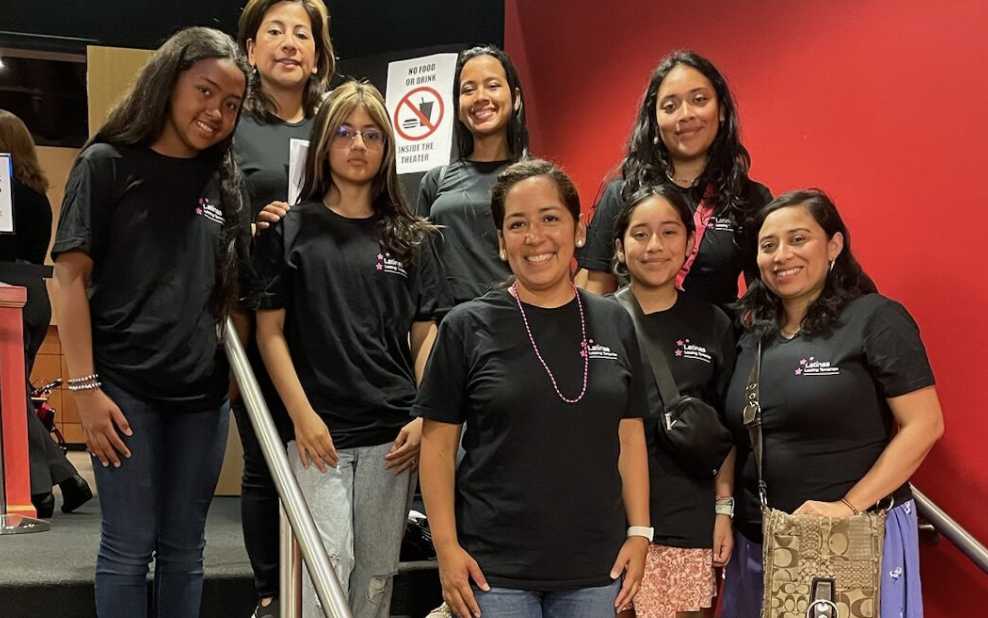
In addition to camps and after-school activities, LLT offers a virtual professional development program that teaches personal branding and provides LinkedIn profile training and resume help, Singhavong said. Every LLT program is completely free.
“We are often dealing with families who would normally not have access to programs like ours because of funding concerns or accessibility,” Singhavong said. “Many of our campers came from fairly far distances each day to get to Marymount because their communities do not have any type of program like this.”
Singhavong — who is first-generation herself — said she has only been with LLT for a year, however, the organization has been running multiple programs for young Latina women for over 10 years.
Its mission, she says, is to combat a common stereotype that she has seen and faced herself: one that Hispanic women are meant to be caregivers and not dream of having professional careers.
“We focus on just girls because many Latina women are taught to be caregivers from a young age, but we want them to focus on themselves and what they want to do in their future,” Singhavong said.
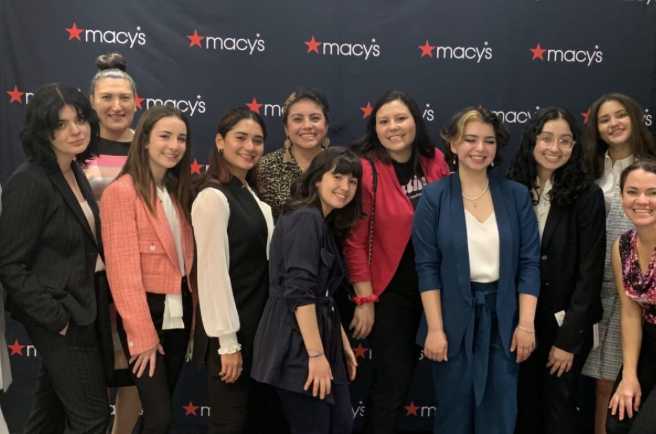
An Arlington Tech robotics team has an unusual strategy for building camaraderie and raising money ahead of competition season: yard work.
Every fall, members of the Koibots weed, rake and landscape around 40 yards in Arlington. Money funds the cost to pay for robot parts and travel and lodging when competitions start in March.
“We’re kids, we all we have the ability to go out and break our backs for four hours on a weekend, shoveling, raking leaves and whatnot,” says rising senior Madeline Florio. “It is a service that people do need and we are able to provide it. Our customers are pretty loyal.”
The team’s coach, engineering teacher Steve Nystrom, says yard work hones their ability to communicate and work together, which comes in handy during the building phase.
“So when you start making the robot, you need to know, who can I depend on? Who can I count on? Who has the skill sets?” he said. “Ironically, you can build a lot of that and know a lot of those answers by going out on yard jobs.”
This kind of fundraising makes the Koibots an anomaly, says rising junior Anna Litwiller. Most teams get large sums of money from Boeing, Lockheed Martin and sometimes the Dept. of Defense.
The yard work might provide the team a competitive advantage, especially considering how well they’ve performed in their short existence.
Despite being in existence for just five years and having constructed only three robots, the team has twice made the cut-offs for districts — where the top 50% of teams in D.C., Virginia and Maryland compete in the spring.
This year, the Koibots came in 36th out 0f 60 and won an award for its design and branding, which leans heavily into its quirky culture influenced by marine life.
Nystrom said he chose the name “Koibots” because Arlington Tech’s Frisbee team is called “The Kois.” After naming their second robot “Sharkbait,” the aquatic theme stuck.
“We try to do as much as we can send her around the fish, and the IKEA shark, and all sorts of aquatic things,” says rising junior Shangwen Cheng. “We highly encourage our team members to get a shark because they’re wonderful but it really brings together our team in a way that you really can’t from the engineering alone.”
“Obviously, we’re here to encourage a love of STEM and building things and learning all things technical, but it’s also a lot of fun and you get to throw sharks around at people,” she continued.
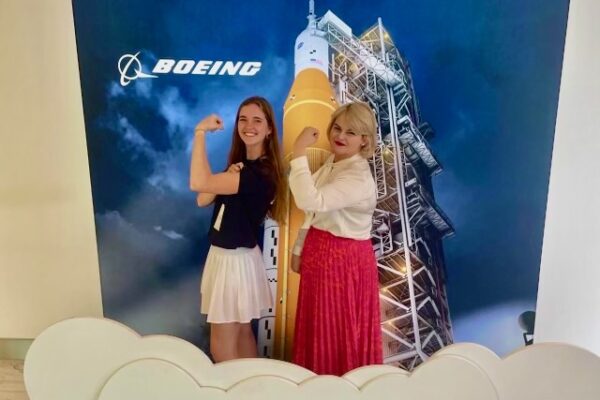
Washington-Liberty High School senior Ava Schwarz always wondered about outer space.
But she did not always love the fields that made the heavens intelligible: science, technology, engineering and math.
That changed once she moved to Arlington and got an internship with Rosie Riveters, a nonprofit focused on promoting STEM education among kids 4-14, particularly girls.
“She took an initial spark of an opportunity and made it her own through our connections and resources,” says Rosie Riveters Executive Director Brittany Greer.
The internship opened doors to more opportunities — including a competition through NASA in which technology she and other W-L students made was launched into space. It culminated with Crystal City-based Boeing holding a STEM Signing Day on Tuesday, as a diverse array of promising students signed a letter of intent to pursue degrees in STEM in college.
“I’m just excited to work in the orbit of her future,” Greer said.
The aerospace company honored 34 Virginia high schoolers, including Schwarz, who plans to study aerospace engineering at Yale University, and Alex Anderson, a soon-to-be Arlington Career Center graduate set to attend William and Mary University to study computer science.
The day hyped up students who will study STEM the way other schools celebrate students signing to play with college sports teams.
“We heard a lot of encouragement,” Schwarz said. “It can be so intimidating so it was cool to have so many people tell you you can do it and that this is an exciting time to be in STEM.”
There was also a message that felt tailor-made for her. One young graduate — a self-described “bubbly” woman — encouraged Signing Day participants to be themselves even if it might not fit engineer stereotypes.
“She said… bring your fullest self to table — that’s how you’re going to be most effective,” Schwarz recalled.
Boeing has been a long time supporter of Rosie Riveters, which began referring students for the STEM Signing Day last year, Greer said. Boeing, for instance, makes possible its education opportunities on military bases.
Going to Boeing’s corporate headquarters in Arlington (929 Long Bridge Drive) this week with Schwarz brought Greer “full circle.”
“She hadn’t had an interest in STEM prior to Rosie,” she said. “It was a clear example of the amazingness of what a public-private partnership can look like.”
Sponsors of her program, including Boeing and Amazon, make it possible for the nonprofit to go into schools and show students what STEM careers look like and what scholarships or internships are available to get them into those careers.
“It’s not just something where they got lucky to hear about it: it’s something they’re being actively called to and their families can support the path to that opportunity,” Greer said. “There’s an incredible amount of talent in our backyards and Ava is evidence of that.”
Schwarz was grateful for the opportunity and the support of Rosie Riveters for helping her push through when she was outnumbered 10-to-one by boys in her engineering classes.
“It’s amazing to have this community backing me, reassuring me that I may be one of the only women in room, but as time goes on, the whole next generation coming up and there will be more women in the room in the future,” she said.
Schwarz going from unaware of STEM opportunities to participating — along with other students of diverse backgrounds — in Boeing’s signing day is proof of concept for Greer.
“You’ve really got this movement of these awesome companies who are based in Arlington and the surrounding area, who are invested in local talent… particularly for groups who haven’t been represented in those spaces,” Greer said. “It’s a more effective, efficient way to invest in the pipeline.”
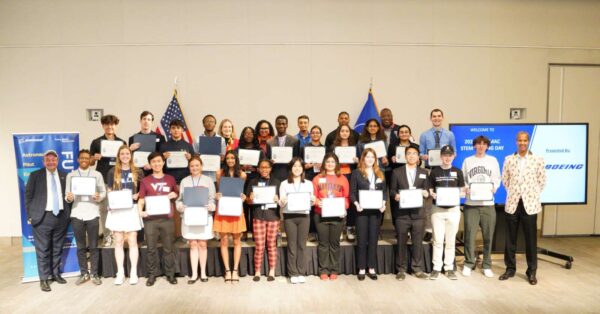

Amazon and the Cal Ripken, Sr. Foundation are standing up a new STEM center at Randolph Elementary School (1306 S. Quincy Street).
“The center will provide new state-of-the-art STEM equipment and furniture for students to learn and play,” a spokeswoman for the Baltimore-based Cal Ripken, Sr. Foundation said. “Giving elementary and middle school kids access to STEM learning is a priority of the Cal Ripken, Sr. Foundation.”
There will be a ribbon-cutting event today (Tuesday) at noon during which students can try out the educational activities.
“Students [will] take part in a hands-on learning activity with the Sphero BOLTs, led by Amazon robotics experts to explore the STEM equipment the new center has to offer,” the spokeswoman said. (The Sphero BOLT is a spherical robot with programmable sensors that kids can control with an app.)
Amazon’s second headquarters is under construction just a few miles from the elementary school. Since it announced its HQ2 plans, the tech giant has donated money and facilities to Arlington Public Schools, with a focus on science, technology, engineering and mathematics.
It has awarded grants to individual schools, funded a new STEM lab at Wakefield High School and announced plans to co-locate Arlington Community High School within HQ2.
Meanwhile, the Cal Ripken, Sr. Foundation, founded in 2001. has placed a greater emphasis on STEM education in recent years. Since 2016, it has started 261 operational, turnkey STEM programs in 19 states, the spokeswoman said.
The nonprofit, which honors the legacy of the Baltimore Orioles player and manager — and father of baseball legend Cal Ripken, Jr. — provides programs and parks for at-risk youth.
The ribbon was cut Monday for Amazon’s new “AWS Think Big Space,” a STEM-focused tech lab, at Wakefield High School.
The lab is located on the ground floor of the school at 1325 S. Dinwiddie Street and is divided into several technology stations, including 3D printing, E-sports, cybersecurity, virtual reality, coding robots Sphero and robotics.
Virginia Secretary of Education Aimee Guidera, APS Superintendent Francisco Duran, School Board Chair Reid Goldstein and County Board member Matt de Ferranti all gave speeches at the opening ceremony and joined the lab tour.
Many of the officials believed that the new lab would better prepare students for future careers in STEM.
“We truly believe in the necessity and the importance of creating opportunities for our students,” Duran said in his speech.
“In Arlington County, there are many businesses and jobs that are available to students who leave our school system not prepared to enter into that workforce. It’s our duty, it’s our responsibility to create those skills and pathways for students to be able to access those jobs,” he added.
Wendy Maitland, a teacher at Wakefield High School, is set to become the manager of the lab. She planned to offer the space to teachers there to assist in their teaching.
“For example, if they want to do something in terms of astronomy, they can come down and use the program on the VR,” Maitland said.
She also is planning joint programs with the nearby Barcroft Elementary School at the lab. Other Arlington schools are also expected to use the space.
Maitland approached Amazon for funding to create a STEM lab two years ago. Donor and local apartment building owner Ralph Johnson joined her effort, she added.
“We created a presentation, they liked it and they came back to us and said, ‘Yes, work with our AWS team because they have the Think Big Spaces,'” Maitland said.
Amazon chose to build its Think Big Space at Wakefield because the high school is the “neighborhood high school” for employees working at Amazon HQ2, Arlington School Board Chair Reid Goldstein said.
“At Amazon, we’re proud to call Virginia home, we’re committed to making a positive impact in the communities where we’re located,” Amazon’s Vice President of Economic Development Holly Sullivan said in her speech.
Wakefield High School is also the most diverse high school in Arlington and the second most in Virginia, Guidera said, adding that she believed building the STEM lab there would be “a great opportunity” — especially for children from underrepresented communities — to access “innovative spaces like [the lab] that make learning comes alive and also expose students to the future of work.”
Although no concrete plans have been drawn up yet, Amazon is considering exchange programs for students engaged in the 35 Think Big Spaces across the world, including India and Ireland, Sullivan said.
The lab will operate as a public-private partnership, with financial support from large local employers like Amazon, Guidera said.
Amazon contributed $150,000 and Johnson gave $109,000 to build this lab. The School Board approved its construction last October, according to School Board documents.
A similar lab funded by Amazon was built at an elementary school in Prince William County is 2019, but Wakefield’s is the first to be built in a high school in the Americas, according to material from a School Board presentation.
Virginia Gov. Glenn Youngkin, Sens. Mark Warner and Tim Kaine, and Rep. Don Beyer joined the leaders of Boeing and Virginia Tech at the former’s Crystal City headquarters this morning to announce a new veterans initiative.
The announcement that drew the state’s top elected officials was the creation of the Boeing Center for Veteran Transition and Military Families at the new Virginia Tech Innovation Campus at Potomac Yard in Alexandria, just down the road.
It comes just over a month after Boeing announced that its existing Crystal City office campus would become the company’s global headquarters. While the move will only result in a relatively small shift of personnel from the existing headquarters in Chicago, it was highly touted by Youngkin, Warner and other elected officials.
“Boeing’s recent announcement to move its headquarters to Virginia and reaffirm its commitment to building the next generation of tech talent is a timely development for the Commonwealth, and is made more exciting by their extensive partnership with Virginia Tech,” Youngkin said in a statement.
“Their pledge to create the Boeing Center for Veteran Transition and Military Families ensures that the Commonwealth and its businesses continue to invest in diverse career pathways for veterans and students alike, all the while helping businesses thrive,” the governor continued.
The new Boeing Center, part of the company’s previously-announced $50 million investment into Virginia Tech’s new campus, is set to provide veterans with “economic and workforce programs,” mental health resources, and community service opportunities, according to a separate news release from Boeing.
“This is just a very important service that our military veterans need, a big assist to get into civilian life and to pursue civilian livelihoods, and to pursue tech degrees and all those things,” Boeing CEO Dave Calhoun said during the announcement.
“Virginia has about 725,000 veterans that call Virginia their home, 155,000 active duty, reserve and National Guardsmen, and I’m biased, I want them to stay in Virginia,” Youngkin said during the announcement.
In addition to the veterans center, Boeing also plans to provide scholarships to Innovation Campus students, facilitate the recruitment of faculty and researchers, and fund STEM initiatives to underserved K-12 students.
“I hope it gets very big,” Calhoun said. “Just suffice to say, we’re going to take advantage of this location and try to attract as many young people as we possibly can to this trade and to our company.”
The press release from the governor’s office is below.
Sponsored by Monday Properties and written by ARLnow, Startup Monday is a weekly column that profiles Arlington-based startups, founders, and other local technology news. Monday Properties is proudly featuring 1812 N. Moore Street in Rosslyn.
After a turbulent two years, a Ballston-based weightless flight company named ZERO-G is once again ready for take-off.
The company, with its administrative headquarters at 4601 N. Fairfax Drive, announced a recent financing round led by private equity firm Rock Mountain Capital. ZERO-G’s CEO Matt Gohd said this investment will help purchase another plane, add more takeoff cities for its consumer flight program, and support the company’s renowned weightless research lab.
Founded in 1995, ZERO-G chartered its first specially modified Boeing 727 boasting a “microgravity experience” in 2004, and has since hosted scientists and celebrities from Stephen Hawking and Buzz Aldrin to Kate Upton and Martha Stewart. Early investors and riders included Tesla founder Elon Musk and Sergey Brin, the co-founder of Google. ZERO-G has also conducted 211 research missions on its Federal Aviation Administration-approved planes, leading to major advances in multiple industries.
“Our goal is to provide the most accessible, most unique extraordinary experience that someone could have — literally, floating like an astronaut in ZERO-G — while being able to support growing research in microgravity,” Gohd said.
The upward trajectory came to a halt in 2019, when the company had major issues that kept the planes grounded, according to the CEO. The financial distress was so extreme that the company could not make payroll and in November, the previous CEO resigned and Gohd took the helm.
The new CEO raised a “rescue round” of funding, began charting a new course for the company, and watched the first plane of his tenure take flight in late January 2020. But one month later, the research staff started talking to him about the coronavirus.
“They said it would be much worse than people thought,” he said.
They were right: Flights were canceled through July 2020 and 90% of staff were furloughed.
But now, with the end of the pandemic in sight, the appetite for microgravity is skyrocketing, he said. ZERO-G resumed operations in August and sold out most flights, a trend that has continued this year.
For about $7,000, people can buy a seat on a flight or for $175,000, companies and groups can charter the entire plane. ZERO-G also makes money from studios shooting movies and commercials on the plane.
“There’s nothing that compares to what we do,” Gohd said.
With the funding he started raising in August, the CEO envisions buying a plane or two to meet this rising demand. The funding will also support research, which he said is the fastest-growing sector of ZERO-G’s operations because of renewed interest in space.
ZERO-G works with NASA and a number of universities to run experiments in microgravity, to see how fluids move or to see how things react in Martian or lunar gravity, both of which ZERO-G can simulate. Outside of ZERO-G, many researchers have no other way to do this work without incurring huge costs, he said.
“We’re the only way to provide an interactive platform for researchers,” he said.
Rock Mountain Capital founder, David Stonehill, now a board member for ZERO-G, commended Gohd for revitalizing the company and credited him for its growth.
“ZERO-G’s unique experience is valued by consumers, corporate customers, entertainment companies, and scientific research teams at NASA and beyond,” Stonehill said in a statement.
(Updated 5:45 p.m.) Washington-Liberty High School senior James Licato is trying to clean up micropollutants in the Potomac River, and he came up with a solution that vaulted him to the finals of a major science competition.
Licato is one of 40 finalists in the Society for Science’s Regeneron Science Talent Search 2021, the nation’s oldest science and math competition for high school seniors. He developed a sandy substance, using zeolites, that acts as a microscopic net, catching the micropollutants that wastewater treatment facilities miss.
Chosen from 1,760 applicants, top finalists each earn $25,000 in scholarships and can nab between $40,000 and $250,000 if they are named in the top 10. This year’s virtual competition goes from March 10-17.
“Regeneron is definitely prestigious,” Licato said. “It feels great.”
Arlington Public Schools last had a senior — from Wakefield High School — make it to the finals in 1997. Washington-Liberty High School last had two students reach the final round in 1976, and have had four in total since 1942, said Society for Science spokeswoman Aparna Paul. Yorktown High School most recently had a finalist in 1996.
Licato credits the APS science staff with connecting him with extracurricular opportunities to present his work. His teachers also helped him work out the logistics of participating in science fairs and ordered materials he needed but could not obtain.
“The APS science department is awesome and has always been really supportive of everything I’ve done,” Licato said.
Licato said his area of research is a growing one, as more people become aware of the toxicity of these micropollutants. Many known pharmaceutical and personal care products (PPCPs) are toxic to aquatic organisms and perfluorinated alkyl substances (PFAs), found in non-stick and water-resistant coatings, can cause a host of diseases in humans, he said.
“The more we study, the more negative effects we find,” he said.
The benefit of his product is that it could be cheap and scalable because it could use the byproduct of coal fire plants, which normally sits in landfills, he said. It will need more testing and engineering work but Licato believes it has the potential to attract federal funding.
A Boy Scout and avid fisher, Licato has always been passionate about water quality and ecology. He won second place in the Earth and Environmental Sciences at the INTEL ISEF competition, also hosted by Society for Science, for his project removing an anti-diabetic medicine from wastewater.
That project introduced him to Thomas Huff, the Director of the Shared Research Instrumentation Facility at George Mason University, who specializes in researching river pollutants. Licato reached out to him because he needed to access a liquid chromatograph-tandem mass spectrometer.
At first, Huff was “highly skeptical,” but the then-sophomore won him over. He said Licato proved to be more adept with the machine than many senior undergraduate students.
Huff offered him an internship drawing and analyzing environmental samples at the Potomac Science Center in Woodbridge. He and a team of graduate researchers at George Mason University were determining the concentrations of PPCPs near wastewater treatment facilities for multiple grant projects.
Licato became a peer of the graduate student researchers, offering new ideas and mastering the software the team used, Huff said. He also developed methods of analyzing data that the other students and professors still use. The lab received a three-year contract to continue studying micropollutants.
“He was a consummate team member and morale booster,” the professor said. “He even taught tricks and tips to a full professor with 35 years of research experience.”
(Updated at 4 p.m.) In just seven weeks, engineering whizzes at Bishop O’Connell High School developed an app that NASA may draw from as it gears up to land the first American woman and next man on the Moon, in preparation for missions to Mars.
This week, NASA recognized them as one of top 10 teams in the 2020 NASA App Development Challenge, which occurred last fall. Students crunched lunar terrain data to create an app that visualizes the South Pole region of the Moon, and NASA will be using aspects of the 10 winning apps for its own program to help astronauts communicate on and navigate the Moon’s surface.
As members of a winning team, DJO students Alex Janninck ’22, Daniel Kippenhan ’22, Elaine Ly ’21 and Claire Toia ’23, as well as Sevginaz Gurleyici ’23, from the Madeira School in McLean will be able to participate in a NASA leadership event in February.
“It takes confidence, drive and a lot of perseverance,” Bishop O’Connell STEM teacher and team advisor Melissa Pore said. “This was incredible to see them achieve this.”
Students developed the app virtually, using “Code With Me” — the Google Docs of collaborative coding — and talked via Discord, a growing communications platform that is popular among gamers and teens. At the height of the challenge, Ly recalls taking notes in class with her right hand and coding with her left.
A NASA official said during a live-stream announcement that the students “displayed great team work by maximizing each team’s strengths in completing both the coding and non-coding aspects of the challenge.”
The odds were stacked against the students: The team barely met the minimum size to participate and the school went fully virtual (due to a COVID-19 outbreak) near the tail-end of the challenge. Team members also did not have app experience, and only Janninck and Ly could code proficiently — so they mentored other members in the coding language Python, Pore said.
“What adult groups would have persevered when they had to learn a new code and train others?” she said.
NASA wants to use this technology “right now,” said Pore, adding that the app can visualize any planet and is suitable for color-blind people.
“Good for NASA to use our smartest levels of students to figure out tricks they wouldn’t have thought of,” she said. “You taught the adults some lessons.”
Ly, who wrote about the news for the school, said she “wouldn’t be half as interested in engineering if it weren’t for [Pore].”
Always learning, Pore became a licensed amateur radio operator to build satellites with her students, and is working with the International Space Station so her students can learn about and access opportunities in aerospace engineering.
A senior headed to George Washington University, Ly nominated Janninck to take charge next year.
“He’s a really good leader and programmer,” she said.
As soon as Janninck finds another interesting challenge, he is willing to try it.
“We do need to get rest from coding and working really hard,” he said.
Especially since the next challenge could be a 24-hour competition to develop a floating settlement to flee to if a meteor strikes Earth.
“No sleep — it sounds wonderful,” Janninck said.
An new tenant in Ballston helps adults in need of a boost to establish foundational computer skills, ultimately expanding their career opportunities.
Called Computer CORE, the educational nonprofit offers courses in Google Suite, email, internet basics, computer security, community college math and similar fields to underserved adults. The classes help workers increase their salary by $10k on average.
The new educational facility will be located in a 3,500 square foot space in the Ballston Exchange complex, across Wilson Blvd from Ballston Quarter mall. The Ballston Business Improvement District coordinated the agreement between Computer CORE and Jamestown, the building’s owner, a press release said.
Overall, Computer CORE has around 150 students, roughly 70 of which will be able to use the new space, according to a spokesperson. In terms of group demographics, around 70% of all enrolled students identify as women and 95% are people of color, according to the organization’s website.
Though the center is only set to remain in the Ballston Exchange through the end of 2020, there is a possibility to extend the agreement, according to a spokesperson.
The location was partially chosen because of its proximity to a Metro station and Ballston’s nearby amenities, Tina Leone, the Ballston BID’s CEO said in the press release.
Computer CORE also offers help with resume review, the job search process and interview prep. Program applicants must live in the Northern Virginia area, be at least 18 years old, be motivated to find a job and have demonstrated need for the classes, according to the website.
Currently, 350 other students are on a waiting list to attend classes, the spokesperson said.
Photo courtesy Ballston BID




